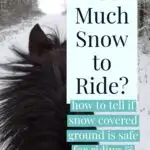For many horse owners, winter is a tough time of year. With less daylight in freezing temperatures, It may be difficult to ride as much as we’d like. Although many riders avoid riding in snow, with the appropriate care taken to preparations the experience can be an exciting and memorable experience – that’s helpful for conditioning and bonding with your horse. It may not be popular at your barn or stable to go riding in the snow, but remember- for much of the history of the relationship between horses and humans, horses were used all winter long as essential transportation.
Important Advice for Riding Horses in the Snow:
In this article, we’ll cover some basic tips for riding horses in snow, essential preparations for a safe snow day ride, and easy ways to stay warm while riding horses in winter weather.
First, Talk to your veterinarian or farrier about your horse’s hooves
First and foremost, consider your horse’s hooves, the footing you’ll be riding on, and traction. If your horse is wearing traditional metal horseshoes, they won’t provide much grip on snow- and even less if you hit a patch of ice.
Generally speaking, barefoot horses have better traction in snow (after all, wild horses have thrived in snowy mountain areas for centuries!). If your horse is not able to go barefoot due to weak hooves or other issues, talk with your farrier about special horseshoes designed to improve traction on snow and other slippery surfaces.
Pro Tip: Some older horsemen swear by greasing the frog of a horse’s hooves with Crisco before riding. While this might sound like it would decrease traction, it can actually prevent snow build-up on the underside of a convex hoof, which improves traction.
Making sure your horse has traction on cold winter surfaces is, without a doubt, the most important part of having a safe and fun ride in the snow. There are many options for improving your horse’s traction on frozen footing, including horse boots that surrounded the house with grippy rubber, horseshoe pads that protect sensitive parts of the host from sharp frozen ground, horseshoes that accommodate snow cleats, and others.
While any of these options provide more traction than plain metal horseshoes, there’s limited evidence that any of these options provide more traction than a natural bare hoof.
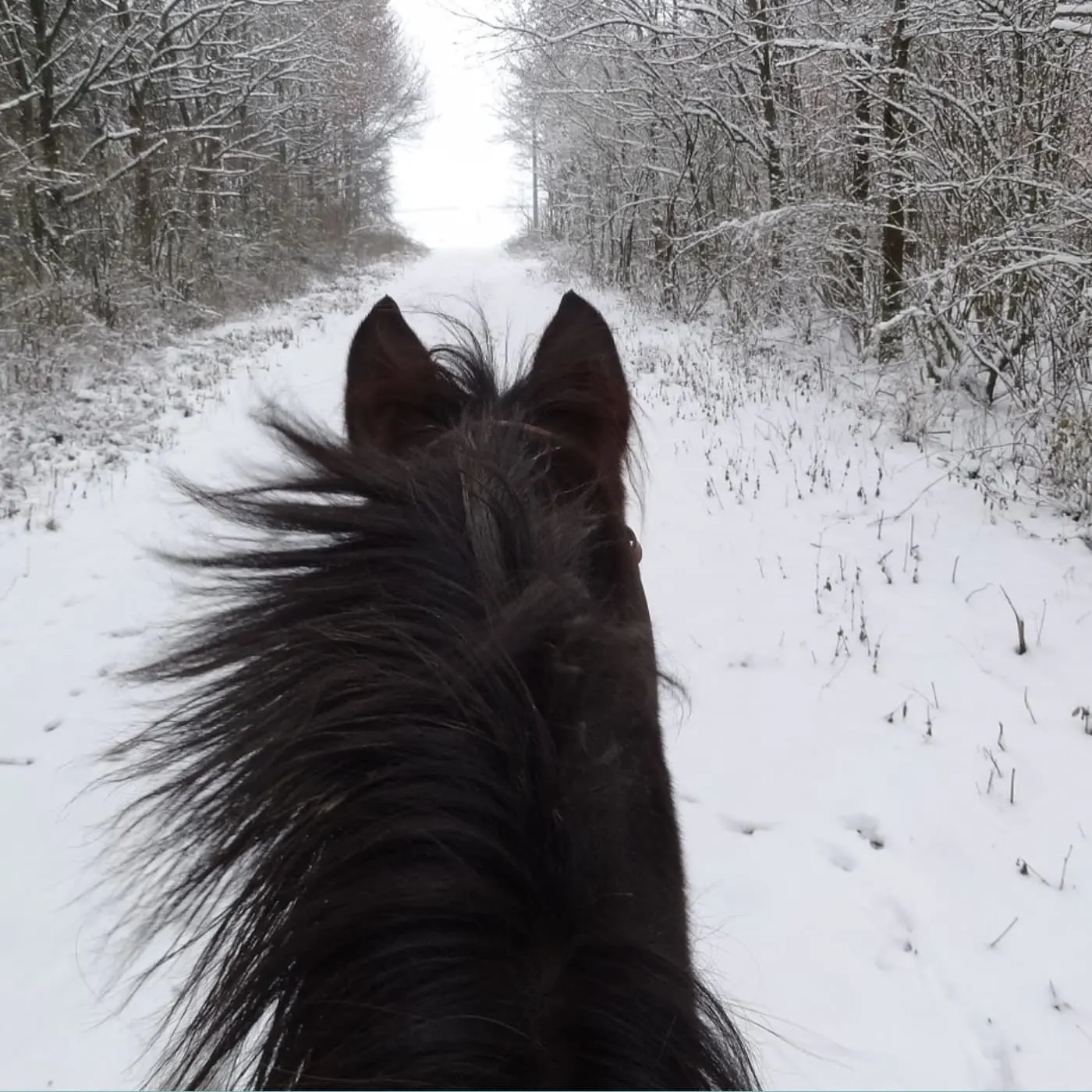
Don’t overwork your horse
Think about how much harder it is to trudge across a snowy sidewalk than a clear one, and use this to adjust expectations for your horse’s fitness. Walking in even a few inches of snow adds a physical challenge for horses, and deep snow can be very taxing- especially if the horse has not been ridden regularly in the winter months. Although you may enjoy a brief canter through fresh powder in an area where you trust the footing beneath the snow, riding horses in the snow should mostly be limited to walking.
If you get a chance to ride in deep snow – like over your horse’s knees- keep in mind that your horse is working very hard to push through the snow. Take plenty of breaks, even if your pace is only walking. Monitor your horses breathing. If their sides are heaving, they need more breaks or a less taxing route.
Only ride horses in the snow if you are familiar with what is under the snow
It’s amazing how a few inches of snow can completely transform a landscape – and the same is true for the footing that you’ll be riding your horse over. While you can trust that a maintained riding arena will have good footing under the snow, the same is not necessarily true for trails or even pastures where you might ride your horse.
Know your terrain – ditches, fallen branches, farm implements, and more can get covered in deep snow – the world looks flat and perfectly safe but as a rider, you’ll need to be extra cautious of any hidden surprises under the snow. For this reason, it’s best not to ride a horse in the snow unless it’s in a space that you are extremely familiar with the footing already- fallen logs and even frozen streams can turn invisible when blanketed by snow, so stay to a walk in any area where there could be hazards under the snow.
Wear special clothing for horseback riding in the snow
While I’ve written previously about what to wear horseback riding, there are special considerations to think about when choosing what to wear to ride horses in the snow. Of course, the basics still remain true – comfortable, accomodating pants and a helmet – but when riding horses in snow you’ll want to give extra consideration to wearing extra long sleeves so your wrists stay warm when your arms are extended (something traditional coats don’t always consider) and a jacket that is split and extends over your hips.
A jacket with split tails not only keeps outer thighs warmer, but in the event that you have to duck under a snowy branch on the trail, you won’t find the back of your breeches filled with wet snow flung from a low hanging branch!
Warm your tack before you ride
Most of us have heard that it is important to warm up a bit before putting it in a horse’s mouth on a very cold day. What you may not realize is that it can also be helpful to warm up other tack before riding.
Placing both your saddle and bridle in a warm place while you groom and prepare your horse for your snow ride can make the ride more comfortable for both you and your horse. After all, an icy cold saddle placed on the large muscles of a horse’s back can be unpleasant and potentially even cause a horse to dangerously misbehave, in reaction to the discomfort.
Watch the weather
Horseback riding in the snow tends to be spontaneous. You may suddenly decide to saddle up and go for a ride while checking on your horse after a big snowstorm- but before riding, especially if you plan to head out on a snow-covered bridle trail, check the weather. If more snow, sleet, rather winter weather is looming, it’s best to wait until another day to enjoy the snow on horseback.
Avoid snow-covered or icy roads
Because there are fewer cars on the road during winter weather, it may be tempting to ride on the wide-open paths of a road with freshly fallen snow, but don’t. The hard, slick surface below is unforgiving if a car comes along unexpectedly and you and your horse have to scramble off the road.
It’s best to give a wide berth to any roadway when riding horses in the snow. Instead, while riding your horse in the snow, you should stick to fresh, soft powder – not the kind of slush, crust, or ice that collects near paved roads.
Remember, your horse has less traction in the snow and snow can conceal dangerous black ice on asphalt which is extremely dangerous even if there are no cars involved.
While riding along the roadside may be safe in some conditions, drivers driving on snowy or icy roads may be hyper-focused on the road just a few feet ahead of them and not notice a horseback rider in the snow on the road ahead. To keep you and your horse safe, don’t take any chances with snowy roads.
Use the buddy system
It’s a good idea to bring a friend along any time you’re going out horseback riding in the snow. It’s even better if both you and your friend are familiar with the area that you are riding in– like a field you’ve ridden 1,000 times before or a trail you follow regularly. Your riding companion can help point out hazards that might be hidden by the snow. If one horse or rider run into trouble, you’ll have help managing whatever challenges come up.
Consider riding bareback
Saddle pads and saddles can make riding more comfortable, but they also provide thick insulation between the warmth of your horse’s body and your own. If you’re already comfortable riding bareback, this riding style can be a great way to stay warm while riding in the snow.
Avoid thawed and refrozen snow or riding in snow that fell as a “wintry mix”
While snow makes a decent footing for riding, ice does not – and snow that falls on top of ice may be even more dangerous than plain ice, because it is hidden.
Similarly, deep snow that has gone through a few warm days and partially thawed before refreezing can form sharp and jagged ice-edges that can potentially cause cuts and scrapes on horses’ legs. For enjoying a safe ride on your horse in the snow, fresh snow on frozen ground is best.
Never underestimate the power of snow
Snow has mass- a lot of it! While it may seem like your horse has the horsepower to plow through anything, snow – especially snowbanks – have the potential to rapidly off-balance you and your horse. There are stories about horses flipping over and causing a dangerous rotational fall when being ridden into a snowbank too quickly. Respect the power of snow in order to enjoy your snow ride.
Final Thoughts on Riding Horses in the Snow
While it’s best to avoid riding horses on ice, snow can make for fun and memorable winter horseback riding. To make the most of your snow ride, buddy up, watch the weather, dress appropriately, and only ride in areas that you are familiar with. With your equine companion and enough warm clothing, you can create memories and begin conditioning your horse for horse show season through regular winter riding in any weather.
Winter Horse Turnout in Snow
Horses are, for the most part, incredibly well-suited to snowy conditions. Convex hooves and thick winter coats make most horses more comfortable in snowy conditions than in high humidity heat. That said, there are still some wintry conditions that are unsafe for a horse to be turned out in.
Read on to learn more about winter turnout do’s and don’ts.
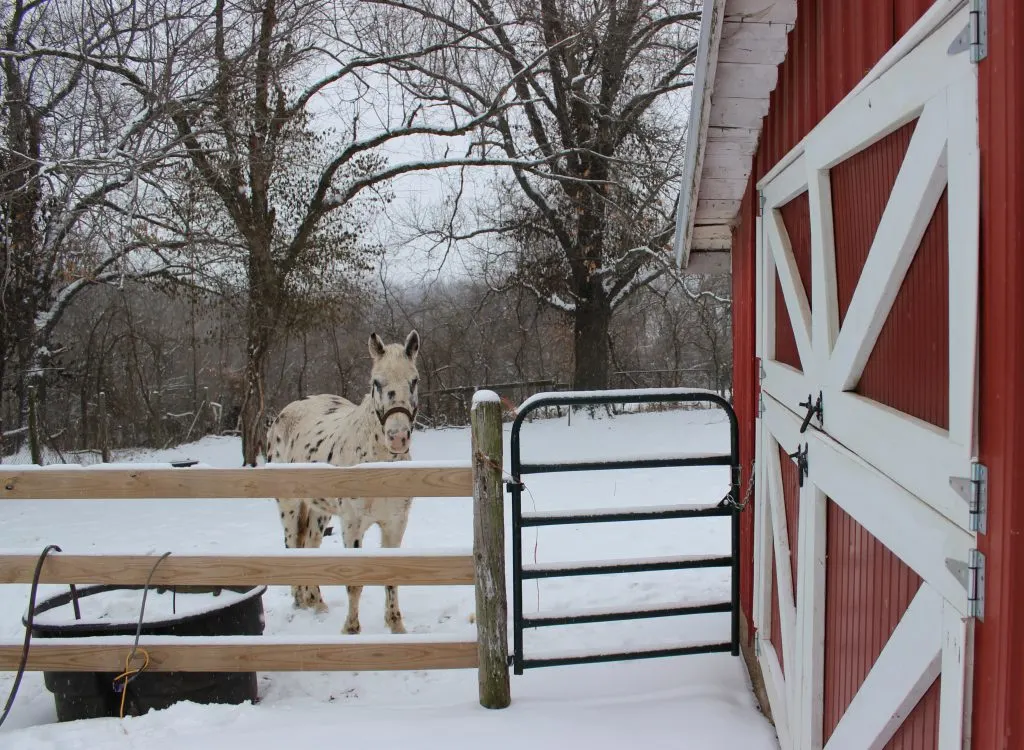
How do you decide if your snow-covered pasture is safe for turnout?
In my first seven or eight years of horse ownership, I would have said that an abundance of caution should be exercised when considering whether to turn out horses in a wintry snowy pasture. I would have encouraged the judicious turnout of horses in snow-covered pastures only if the snow was soft but still frozen – not too hard and not slippery slush.
That all changed in the winter of 2008 when Southwest Missouri experienced the worst ice storm anyone could remember hitting the area. Many rural areas went without power for weeks on end, on our far power was restored 10 days after the initial storm. Those 10 days challenged our winter horse keeping skills and norms, forcing us to trust our horses a little bit more and to rely on their instinct to navigate the dangers of a snowy and icy pasture.
I’ve written at length about our creativity in keeping water tanks thawed without electricity and in this article I’m talking a little more about turnout in icy pastures.
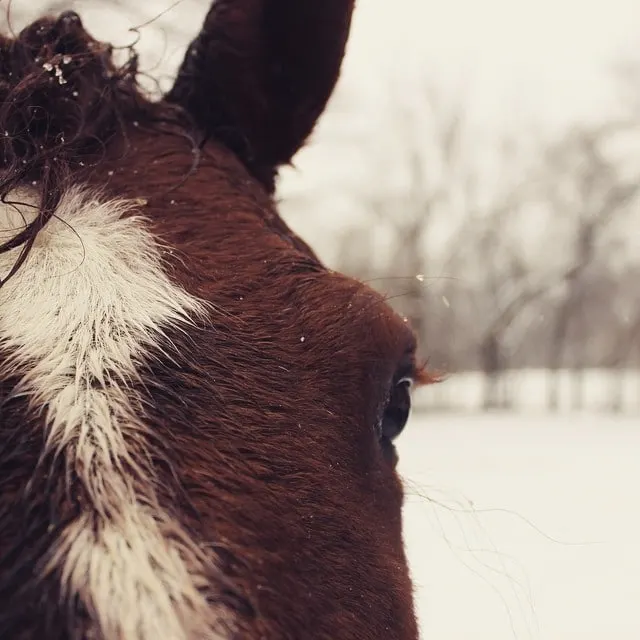
Why I Leave My Horses Turned out During Winter Storms
The interesting thing about an ice storm that leaves 1-2 inches of solid ice on the ground is that the sounds of a farm change. Between the cracking of ice and the utter silence, I noticed that I could hear each of my horses’ footsteps in the pasture, even from inside my home about 150 yards away.
For several reasons, we chose not to keep horses in the barn after that winter ice storm had passed. We kept stalls closed for a few hours during the initial rain-turning-to-sleet phase of the storm, then immediately turned them out (with access to a shelter with hay) even though there was solid ice frozen on the ground. Why? The forecast promised that the ice would remain for more than a week, and for various reasons we were not comfortable keeping the horses in stalls that long.
Rather than keeping them in for a few days and then letting them out (with the boundless energy that accompanies turnout after days of being stalled), we chose to let them have free range of the icy pastures. By allowing horses access to the icy fields, we avoided having to eventually release over-energetic horses onto slick ice or dangerously slick post-thaw muddy pastures, and instead left them loose and trusted their instinct.
Letting the horses free-range through and beyond that storm gave them the opportunity to exercise just as much as they needed to.
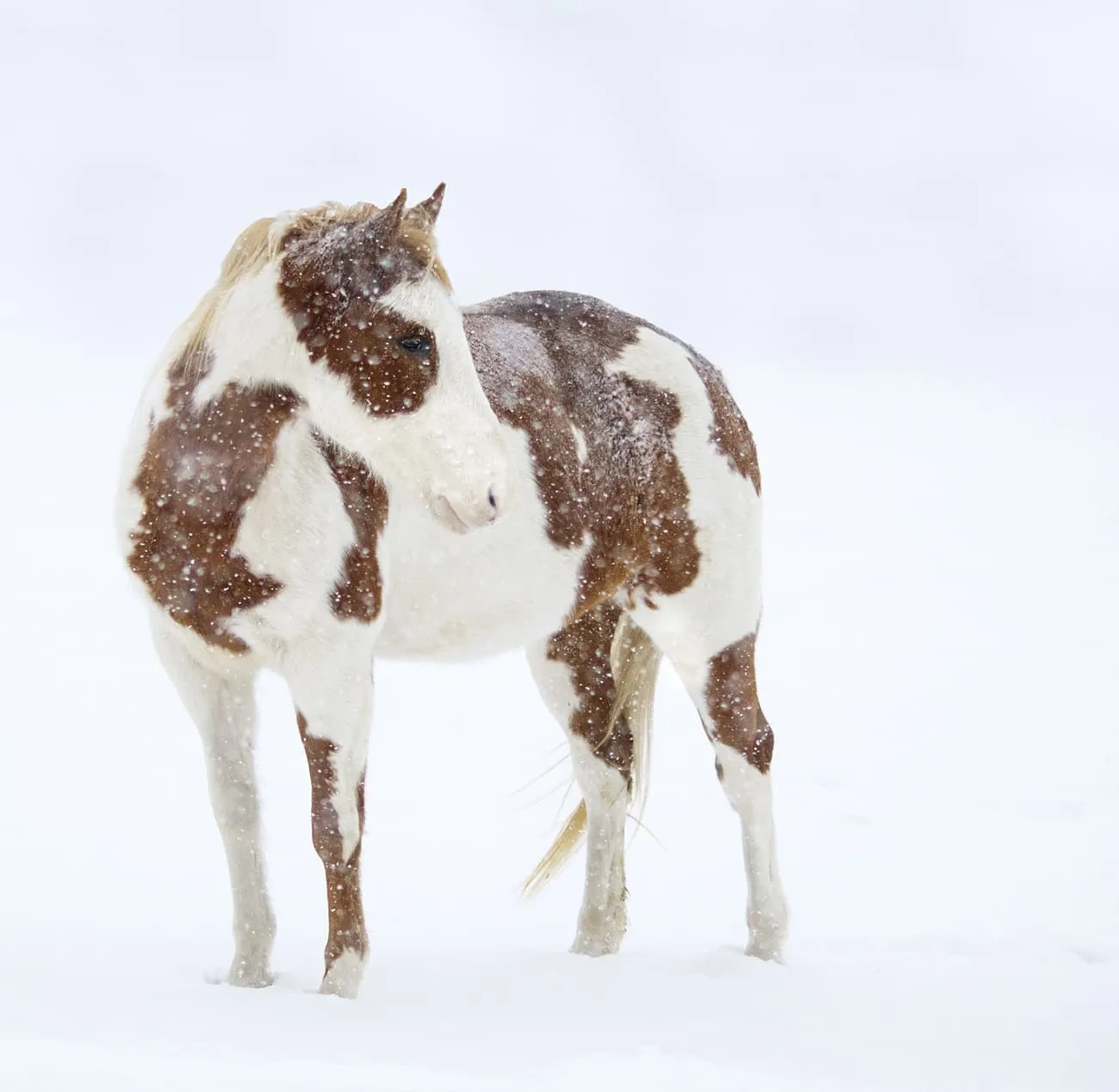
Horse Turnout in Ice-Covered Pastures
I realized as I listened to my horse’s hooves reverberate on the solid ice through those days and nights of eerie silence, that they were each taking themselves on a slow, careful walk around the perimeter of the pasture about once per hour. This fascinating experience led me to grow more trust in my horse’s intuitive ability to know when and how to move on ice and other conditions.
After this, ice storm experience I began to leave my horses turned out during all sorts of storms and weathers – only bringing them in during lightning storms.
Horsekeeping in Snow
Most horses will avoid running in snow and ice unless they are feeling the energy build-up caused by being kept in a stall. This image shows Silver Red Ebony, one of our former broodmares, running through a snowy pasture in December. This horse’s white color almost blends in with the snow.
Many horses with thick winter coats, like Bashkir Curlies, don’t usually need to be blanketed with horse blankets in this type of weather. Their winter coats are thick enough to keep them warm in most temperatures. Putting a winter horse blanket on a horse with a good winter coat actually makes horse’s own coat less effective in keeping them warm- long after the blanket is removed. Horses naturally warm themselves by puffing up their coats. When a blanket is added, the hairs are made to lay down and, if the blanket doesn’t compensate sufficiently for that with insulation- can potentially make a horse colder.
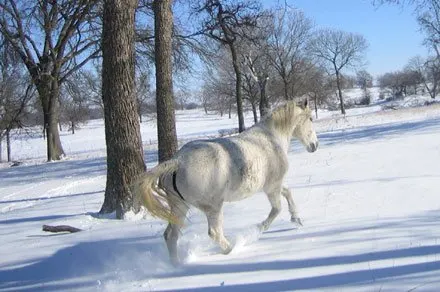
The picture below shows our white mare trotting through the snow in our back pasture after a snow fall in December of 2006. Our horses were happy to get turned out and played happily in the soft fetlock-deep snow. Notice our Chestnut mare, Lucy, following close behind! Some types of snow are perfectly safe to turn a horse out on- it provides a soft but somewhat supportive footing.
Most horsekeeping experts advise that horses should not be allowed out on snow, because the danger of slipping is too great. Generally, they say, ice or hard frozen snow on top of mud provides unsafe footing for horse turnout or riding, but soft snow covering footing that is safe and well-drained is fine to ride on or allow horses to play on.
Trouble Areas
Even if you trust your horse’s winter instincts- like our tough and snow-loving Bashkir curly horses- and chose winter turnout, it is a good idea to take note of footing around water troughs and stock tanks, and this area can be dangerous- particularly if it is trampled and partially thawed in the day, and frozen again overnight. While a horse can navigate this tricky footing, troughs can become a crowded hot-spot for group turnout and any scuffles between horses on this treacherous footing could be unsafe.
If you note that the footing around your trough is particularly bad, there’s not much you can do in winter weather (short of the laborious process of draining, moving, and refilling) but you may want to make a note to made footing upgrades before next winter.
Click here for more information on horseback riding safety.

